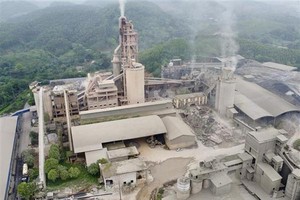A delegation of high-ranking officials on April 1 went to examine the dam in Song Tranh 2 hydropower plant in Bac Tra My district in the central province of Quang Nam, to find and discuss methods to repair the cracks in the dam.
Thai Phung Ne, Government Special Envoy; Hoang Quoc Vuong, Deputy Minister of Industry and Trade; Le Quang Hung, Director of the Department for state control of quality construction, were joined by local senior officials.
To date, no cracks in the dam have been found, according to the deputy minister, who concluded that the plant "remained safe and stable".
Water levels in the dam are now 160 metres high and because of rain in Quang Nam Province on March 31, the water flowing into the dam is now at the rate of 50 cubic metres per second.
However, the officials assured of no more leaks from the biggest dam in central Vietnam, where only a couple of days ago 30 litres of water per second was gushing out as compared to seven litres per second now.
They also said that the dam will release water to the dead level by mid-April and full repairs will be complete before the flood season.
Vice Minister Vuong said the leak had reduced after the EVN adjusted repair methods "The leak at the US$250 million Song Tranh 2 hydropower plant needs to be curbed by the said deadline or by the end of March if possible," he said at a press meeting in the capital yesterday.
"There's no possibility of any further accidents that could cause damage to low-lying areas," Vuong said.
This information was confirmed by Dang Phong, Chairman of the People's Committee of Bac Tra My District. He told reporters that repair works will be carried out by the Management Board of Hydropower projects 3, an Electricity of Vietnam unit which directly manages the plant.
The 96m-high dam, part of the hydropower plant in Quang Nam Province that began operations in January 2011, is capable of holding 729 million cubic metres of water.
Minor quakes, measuring 3 on the Richter scale, were recorded in the surrounding area earlier in 2011.
The plant has passed its first State assessment which allowed it to run at part of its total capacity while awaiting full assessment in May.
Water has been leaking from the dam since February 2012, worsening in the last 10 days.
Water was flowing out through so-called "thermal gaps" — small openings placed between concrete blocks to prevent cracking in the heat, according to the Ministry of Industry and Trade.
While denying any faults in design and construction, officials of the Electricity Construction Consultancy Company 1 admitted that "water leakage outside the dam was abnormal".
Water holes were designed to receive water absorbed from inside the dam's concrete walls (concrete is not an absolute waterproof material) into water ditches before it could leak out of the dam, he said.
Initial assessment by experts from the Ministry of Industry and Trade, EVN and the State Council for Assessment and Acceptance of Construction Works showed some water holes were blocked, resulting in water leaking from thermal gaps.

The Ministry said most of the blocked water holes had been cleared, which reduced water leakage and the unblocking process was expected to finish by the end of March.
"More assessment and repair to prevent further water leakage must be done before the flooding season (end of July)," Vuong noted.
Meanwhile, an expert from the Vietnam National Committee on Large Dams and Water Resource Development said that there must be something wrong with the waterproof shields inside the thermal gaps that normally prevent water from flowing out.
"There are technologies available in the world to fix this, but they are very costly," he added.
"It is important to fix these thermal gaps before they get bigger under high water pressure during the rainy season or during earthquakes," he said.
"This means all repair costs must be born by the bidder, the Irrigation Construction Corporation 4," he said.
























